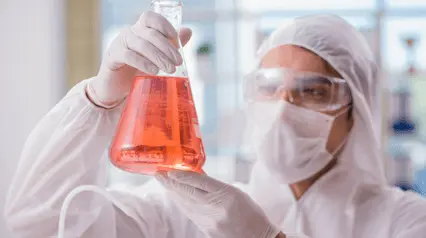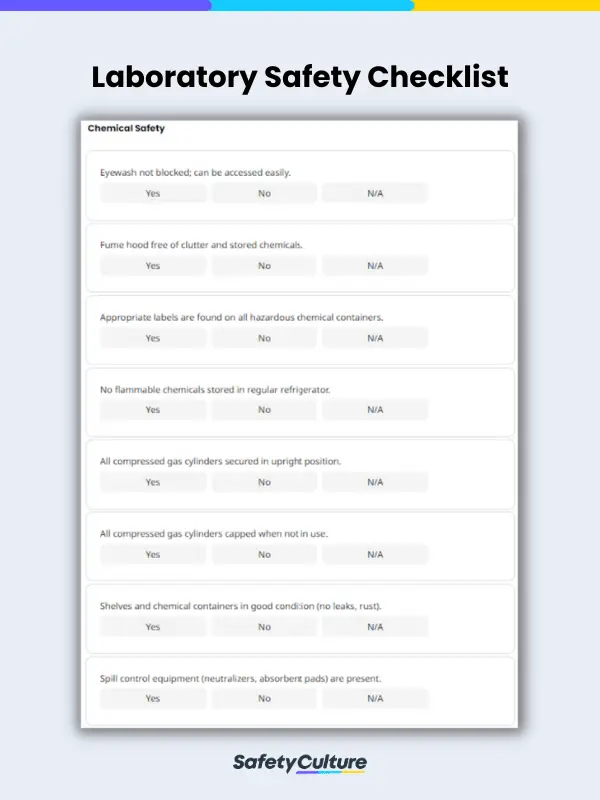What is a Laboratory Safety Checklist?
A laboratory safety checklist, or lab safety checklist, is utilized by lab supervisors and safety officers to identify and minimize chemical, biological, physical and radioactive hazards present in laboratory facilities at schools and hospitals, among others. It helps ensure that the laboratory complies with environmental standards to prevent overexposure to hazardous chemicals, injuries and respiratory-related illnesses or fatalities.
What is Laboratory Safety?
Laboratory safety, or lab safety, aims to prevent laboratory risks and hazards to protect students and staff from hazardous chemical exposure. It is implemented to avoid incidents such as fire, explosions, biohazards, and more. Laboratory safety is important as it helps:
- prevent toxic contamination;
- secure the property and equipment from damage; and
- manage an organized and safe laboratory environment.
Types of Laboratory Safety Hazards
For clinical, industrial, and academic laboratory personnel, the laboratory environment can be a hazardous place to work. According to the Occupational Health and Safety Administration (OSHA), here are the different types of hazards workers can encounter while in laboratories:
-
Chemical Hazards
Laboratory chemicals like formaldehyde can include cancer-causing agents (carcinogens), toxins (e.g., those affecting the liver, kidney, and nervous system), irritants, corrosives, sensitizers, as well as agents that act on the blood system or damage the lungs, skin, eyes, or mucous membranes. Air contaminants such as toluene, xylene, and acrylamide require even more specific hazard communication (HAZCOM) and Material Safety Data Sheets (MSDSs).
-
Biological Hazards
Many laboratory workers encounter daily exposure to biological hazards such as blood and body fluids, culture specimens, body tissue and cadavers, and laboratory animals, as well as other workers. These federally-regulated biological agents (e.g., viruses, bacteria, fungi, and prions) and toxins can result in but are not limited to infectious bloodborne pathogens, zoonotic diseases, foodborne diseases, Legionnaires’ Disease, and respiratory problems from molds.
-
Physical Hazards
Some of the common physical hazards that they may encounter include the following: ergonomic, ionizing radiation, non-ionizing radiation and noise hazards. Physical hazards as repetitive movements in the laboratory usually occur during routine laboratory procedures such as pipetting, working at microscopes, and operating microtomes. Moreover, exposure to continuous noise may lead to stress-related symptoms such reduced efficiency and decreased productivity, decreased concentration in the workplace, and increased errors in laboratory work.
-
Safety Hazards
Laboratory personnel should be properly trained to use autoclaves and sterilizers, centrifuges, compressed gasses, and cryogens and dry ice, as well as be able to recognize and remove potential safety hazards like electric shock and electrocutions, small bench-top fires, and slips, trips, and falls.
Overlooked Laboratory Guidelines
Safety issues often arise and go unnoticed due to a lack of protocol, faulty implementation, or oversight guidelines. Most of the time employees tend to overlook simple guides that can lead to possible incidents or bigger issues. You can find below the commonly overlooked safety laboratory guidelines:
-
Dress code safety
Wearing appropriate PPE is one of the basic requirements when working inside the laboratory. All employees must be informed of the proper dress codes to eliminate any risks of chemical contact. Employees must ensure all equipment including goggles, face shields, safety gloves, body, and respiratory protection are in good condition before entering the laboratory.
-
Laboratory waste disposal
Hazardous wastes are classified based on their physical or chemical properties. Commonly, inappropriate disposal can cause an acute or immediate effect on employees’ health and safety. Enforcing proper waste management can eliminate potential hazards, including environmental pollution, pathogenic diseases, and chemical reactions.
-
Ergonomic safety
Repetitive awkward postures can cause discomfort to employees that can lead to musculoskeletal disorders (MSDs), tendinitis, and carpal tunnel syndrome. Proper training on ergonomics safety can help employees maximize their laboratory efficiency and productivity.
-
Proper labels
Labels are important elements of laboratory safety. They help in identifying chemicals, their substance, and the hazards associated with them. A proper label should have the name of the substance, its concentration, the date it was received, and the name of the person responsible for it.
-
Record of an incident
Reporting an incident is essential to raise the organization’s awareness about the things that can go wrong so that corrective and preventative actions can be taken promptly. Keeping a record of an incident can also help both employees and business owners to have evidence in case of an accident to support their insurance claims.
4 Essential Laboratory Housekeeping and Maintenance Tips
OSHA has reinforced rules and published guidance to make laboratories increasingly safe for workers and other people involved. The following tips can help in maintaining a safe laboratory to protect employees from chemical exposures and unexpected incidents.
-
Enforce laboratory standards
All employees must undergo proper induction and training about laboratory standards, emergency procedures, and other policies to keep them informed about the hazards in the workplace. Monitoring employees’ permissible exposure limits (PELs) protects employees from possible harm including respiratory ailments and physical injuries.
-
Keep it clean
It is paramount to maintain laboratory cleanliness throughout the operation to secure the health and safety of employees and the property. Keep the laboratory space unobstructed and clean all spills immediately to avoid accidents.
-
Calibrate equipment
Keep the functionality, quality, and accuracy of measuring equipment to avoid disrupting the entire experiments. Conducting regular equipment calibration helps the organization prevent accidents and damage that can lead to legal action and profit loss.
-
Remove and replace damaged items
Maintain equipment in peak condition to prevent production hitch. Immediately report any damaged equipment either for replacement or removal to avoid unnecessary incidents and equipment malfunction.
SafetyCulture Marketplace: Your One-Stop Work Gear & Equipment Shop
Improve safety in your workplace with SafetyCulture Marketplace as your one-stop shop for all work gear and equipment needs. Get on-demand access to top quality and specialized work gear from trusted equipment brands in the industry—all in one centralized location. Raise the bar of safety and efficiency by empowering employees to request what they need with just a few taps, anytime and anywhere!



